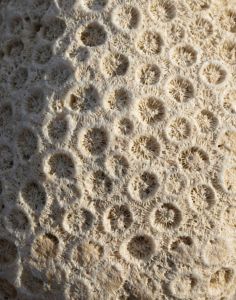Coral reefs are an essential part of marine ecosystems and their vulnerability to global warming is a major concern. Stress to the coral from warming waters can contribute to bleaching, which is the whitening of corals due to the death of algae that live on the coral.
Bleaching of the coral is likely to lead to reduced growth as it is the algae that help the coral grow through calcification (build a calcium skeleton).
New research has predicted that, if current warming continues, an important type of coral in the central Red Sea could stop growing by 2070. Although the same coral has recovered after previous short-term warming events, it appears that the current continuing trend in warming is likely to be more damaging.
 The central Red Sea is home to large number of coral reefs. For the past decade the summer temperatures (during July, August and September) have been on average 1.46°C higher than the historical mean of temperatures (from 1950-1997) of 30.5°C. However, although localised bleaching has been reported, it has not occurred at a large scale, suggesting the Red Sea corals may be naturally adapting to increases in sea temperature.
The central Red Sea is home to large number of coral reefs. For the past decade the summer temperatures (during July, August and September) have been on average 1.46°C higher than the historical mean of temperatures (from 1950-1997) of 30.5°C. However, although localised bleaching has been reported, it has not occurred at a large scale, suggesting the Red Sea corals may be naturally adapting to increases in sea temperature.
Corals vs. high temperatures
The study used historical records to explore the relationship between sea temperature and the growth of the coral Diploastrea heliopora in the central Red Sea for the period 1930-2008. The coral colonies showed no outward signs of stress, bleaching or disease, but there may be more subtle impacts of sea temperature on growth.
The results indicated that as sea temperature rises, the growth of the coral decreases and that growth rates are highest when summer sea temperatures remain below 30.25°C. When the average temperature in summer exceeds 30.5°C, the growth of the coral declines rapidly by 5 % for every 0.2°C increase.
In the early 1940s there was a two-year period where temperatures were at least 3°C above the historical mean and during this time the average annual growth rate of coral decreased by 44 %. This was short-lived and when temperatures dropped the coral growth rates recovered. However, there has been a significant increase in the duration and intensity of heat over the past decade, which corresponds directly with a decline in the coral growth of 30 per cent since 1998.
No coral growth within 60 years?
Looking to the future and using scenarios A1B and A2 from the Intergovernmental Panel on Climate Change (IPPC) report, the study predicts that summer sea temperatures in the Red Sea will continue to rise through the 21st century and may increase by another 2.5-3°C by 2099. On the basis of this and the data collected, the study predicted that the coral D. heliopora will cease growing altogether by 2070, due to significant loss of the algae which aid calcification.
Source: Cantin, N.E., Cohen, A.L., Karnauskas, K.B. et al. (2010) Ocean Warming Slows Coral Growth in the Central Red Sea. Science. 329:322-325.
Contact: ncantin@whoi.edu

 The central Red Sea is home to large number of
The central Red Sea is home to large number of